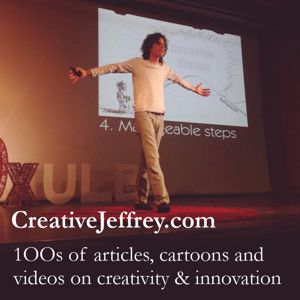Report 103
Your newsletter on applied creativity, imagination, ideas and innovation in business.
Tuesday, 5 December 2006
Issue 95
Hello and welcome to another issue of Report 103, your fortnightly newsletter on creativity, imagination, ideas and innovation in business.
As always, if you have news about creativity, imagination, ideas, or innovation please feel free to forward it to me for potential inclusion in Report103. Your comments and feedback are also always welcome.
Information on unsubscribing, archives, reprinting articles, etc can be found at the end of this newsletter.
GLORIOUS INEFFICIENCY
I had an interesting exchange with a chap from America the other day. He informed me that brainstorming – by its broadest definition – is highly inefficient and that companies could no longer afford to spend time generating lots of ideas in order to find the one or two ideas that would bring benefits. He claimed a ratio of one idea in 100 as being the norm.
Of course he was wrong on two fronts. Firstly, he is wrong in thinking that one idea in 100 has tangible benefits in a brainstorming event. But he is not way off. Where he was terribly mistaken, of course, was in thinking that I would agree with him that an inefficient idea generation technique is a bad thing.
Indeed, Inefficiency in idea generation is a glorious thing – particularly when you want radical, disruptive, industry changing ideas. But even if you will settle for great innovative ideas, you need some inefficiency to discover them.
To understand why, let's look at what efficiency is all about. An efficient system is one in which there is no wastage. For example, a petrol (gasoline) engine in a car is only about 25% efficient. In other words, of all the potential energy in the petrol, only 25% is actually transferred to the crankshaft and on to the wheels of your car. The other 75% is wasted. That waste is in the form of engine heat, friction and pollution.
By that reckoning, brainstorming, or any form of creative ideation, is tremendously inefficient. A group of creative thinkers can easily devise 100 or more ideas to solve a problem – or respond to a challenge. Yet, only a small handful of those ideas is expected to be implemented. Hence, such a system is only – at best – about 5% efficient!
On the other hand, the efficient idea machine (EIM – an imaginary system for generating ideas) might guide thinkers through a series of tools which result in four ideas being generated and two of them being implemented. Thus, the EIM has an efficiency of 50%. That certainly seems a lot better than brainstorming, doesn't it?
At first glance, then, one might assume the EIM is better for producing ideas. After all, half of the ideas produced are implementable.
But, ideas are not like horsepower produced by a car engine or products pumped out by an automatic production line. Ideas vary in value significantly. A good idea might improve your operational process and save your company $100,000 a year. If your company has a turnover of $20 million, that is a half of one percent of turn over and could add a couple of percent to your profit. Not bad.
An incredible idea, on the other hand, might cause you to radically rethink your operations and save you $2 million per year. That's 10% of turnover, which not only results in greater profitability, but also more leverage over your competition with possibilities of cutting prices, adding value to your product, investing in research or funding inefficient idea generation activities in order to continue to stay in front of the competition.
Better still, a radical product idea might bring in millions of dollars in new income AND ensure that your competitor's products are hopelessly out of date compared to yours. Thus ensuring long term gains while your competitors struggle to catch up. Think Apple I-Pod versus all the other MP3 players.
Unfortunately, the EIM, like most highly structured problem solving processes, is very good at helping you identify incrementally innovative ideas. But very bad at helping you generate radical ideas. That's because EIM is a very efficient idea generating system. And like any efficient system, it guides you through a very structured approach designed to generate highly predictable results.
You don't need me to tell you that predictable results are seldom very innovative.
That is not to say that EIM or predictable, incremental innovation is bad. On the contrary, it is good. Companies like Toyota and Dell have grown to be industry leaders thanks to continuous improvement programmes focusing on a steady stream of incremental improvements to their production and logistics systems.
But, when you want to generate those industry shaking, radically disruptive ideas, you need to be inefficient. You need to generate lots of ideas. Moreover, you need freedom to generate wild and crazy ideas that do not follow any structured system. You need freedom to play with ideas that seem ridiculous. You need to generate a lot of rubbish. You need to do all of this to push your mind beyond the usual processes, usual thinking and the industry norms. And to date the only way to do this is to generate a lot of ideas along the way. Most of those ideas will not be implemented.
But they won't be wasted. Those ideas will put you on the path that eventually leads you to the killer ideas. Those unimplemented ideas will clear your mind of the obvious so it can start thinking about the un-obvious. In other words, those unimplemented ideas are necessary to get you to the great ideas.
In short, when you want creative ideas, nothing really beats a good old fashioned ideation session (call it brainstorming, ideas campaigns, group ideation or anything you like) for inefficiency... and brilliant ideas!
Of course, your best bet is to combine both. Structured problem solving for continuous incremental improvement in structured processes and brainstorming and ideas campaigns for pushing the envelope and out innovating the competition.
Note: for more information about ideas campaigns, please visit http://www.creativejeffrey.com/ideamanagement/ for more information about brainstorming and ideation in general, please visit http://www.creativejeffrey.com/creative/
THE BAUMGARTNER WEIRDNESS SCALE
Speaking of outrageous ideas, it can be useful to have some kind of metric upon which to rate whether an idea is an incrementally innovative one, an outrageous paradigm busting one or a totally insane idea that bears little semblance to reality. Sadly, such a scale has been lacking... Until now!
The Baumgartner Weirdness Scale (BWS)is a simple scale which runs from 0-9:
0 – Nothing
If any idea results in absolutely no change whatsoever, it ranks a zero. For
example, imagine a unicycle manufacturer decides to make all her unicycles with
one wheel. Such an idea would not represent any change at all.
1 – Minor change, not noticeable
A very small change that most all people would not even notice receives a 1
on the BWS. For example, if the unicycle manufacturer decides to increase the
adjustability of the seats on her unicycles so that the seats can be raised
an extra centimetre higher or lower, her customers would be unlikely to notice.
Nevertheless, the idea represents a minor change to the product.
2 – Barely noticeable
A change that people might notice if it was pointed out to them, but otherwise
would not notice is a 2. Keeping with the Unicycle manufacturer, a level 2 change
might be making the Unicycles out of a different alloy in order to reduce weight
by 15%. Most customers probably wouldn't notice the change unless a sales person
person informed them of it.
3- Nice
A level 3 change is a noticeable improvement on an existing object, concept
or process. Redesigning the unicycle so that it is easier to balance would rank
a 3 on the BWS, especially if that redesign resulted in a change in the unicycle's
appearance.
4 – Impressive
This is a distinct improvement that impresses people. A computerised unicycle
learning device installed on each unicycle, indicating which way the rider must
lean in order to keep her balance might be a level 4 idea.
5 – Incredible
This is the kind of idea that makes you shake your head and think: “why
didn't I think of that?” A unicycle complete with: (1) a computer balancing
device that prevents it from falling over and (2) the capability of being folded
up small enough to fit into an attaché case so that you could carry it
on public transportation might be a level 5 idea.
6 – Paradigm buster
Popularly known as a disruptive idea, a paradigm buster is an idea that totally
changes the way people think about an object, product, concept or process. For
example: enclosed, self-balancing, motorised unicycles with tiny electric motors
that run off the grid, which people could use to go anywhere – with barely
any energy consumption - might be a paradigm buster.
7 – Outrageous, ahead of its time
An idea which is outrageous, but which might be applied in the future is a level
7 idea. Robot unicycles with weapons that could replace police offices or soldiers
in dangerous environments might rank a 7 on the BWS.
8 – Just weird
At a certain point, an idea is clearly impractical, undoable and just plain
weird. For example, replacing all the cars in the world with enclosed, self-propelled
unicycles is weird and would probably rank 8 on the BWS scale. It's an imaginative
idea, but it's never going to happen.
9 – Insane
Ideas which push the limits of acceptability, which make no sense whatsoever
or which are dangerous are insane ideas. For example, replacing the lower half
of every human being with an organic wheel attached to the knees so that people
could race around on their wheels is an insane idea, particularly if one takes
it seriously.
Level 8 and 9 ideas might seem to serve no purpose, but they do – intellectually anyway. For instance, in a brainstorming event or during an ideas campaign at the unicycle manufacturer described above, level 8 and 9 ideas can inspire people to dream up the level 5 and level 6 ideas you really want to generate during an ideation exercise.
Moreover, it is worth bearing in mind that during a good ideation exercise, the initial ideas are typically at the lower end of the BWS, usually level 2 and 3. As people loosen up, ideas get weirder and go higher up the BWS. At some point, if no one squelches the idea generators, someone comes up with a level 7 or 8 idea. Once this happens, you know your exercise will produce results.
It is also important to bear in mind that most companies are conservative when it comes to innovation. Although their CEOs say they want to innovate, they are often not really ready to take the risk associated with launching a paradigm buster (level 7) of an idea.
As a result, when ideas are reviewed for viability, they almost inevitably drop a level or two in the BWS as committees attempt to reduce risk (and hence creativity) of the top ideas. This is why it is important, when generating ideas, to aim as high as possible on the BWS. By the time the ideas is reviewed and implemented, it probably won't be so innovative any more.
Thus, it can also be useful to push people, during ideation exercises such as ideas campaigns or brainstorming, to aim higher on the BWS. Likewise, when trying to devise ideas on your own, aim high on the BWS. Not only will doing so inspire your creativity, but those really weird ideas, when toned down, can prove to be really innovative.
Go for it!
INNOVATION HUMOUR
If you like innovation and are not a Six Sigma fan, you will enjoy this Dilbert cartoon: http://www.dilbert.com/comics/dilbert/archive/dilbert-20061126.html
LESSONS NOT LEARNED IN INNOVATION
“Every managerial generation rediscovers the need for innovation to drive growth but, decade after decade, 'grand declarations about innovation are followed by mediocre execution that produces anemic results, and innovation groups are quietly disbanded in quiet cost-cutting drives.'” ..or so says Rosabeth Moss Kanter in the Harvard Business Review. Read a summary of her intriguing article at http://hbswk.hbs.edu/item/5525.html
OI SOLUTIONS
Our UK Sales partner, OI Solutions, has put together a couple of intriguing Jenni Marketing idea products which combine our Jenni idea management software service with their substantial marketing expertise in order to provide a complete, innovative marketing idea generation and development product. Bring together OI Solution's marketing expertise, your innovation potential and Jenni idea management in order to devise, develop and implement killer marketing ideas. After all, if you are innovative in your product development, you should also innovate in the marketing of those products. For more information, visit http://www.oisolutions.co.uk/home.aspx or contact Peter Eales on (+44) 01202 706 975. And tell him Jeffrey sent you.
E-MAIL CREATIVITY COACHING
We are experimenting with coaching applied creativity projects in which you download a series of exercises, complete the exercises and send them to me or one of my colleagues. We review your work, provide feedback and send you the next exercise.
The concept behind coached creative exercises is to help you maximise your creative potential by coaching you through a series of exercises which lead to a specific goal or goals.
Coached creative exercises are available for Strategic Innovation, Creative Sales Lead Generation and Creative Self Promotion. You can download and try the first exercise of any of the sets for free. If it works for you, follow the complete course – I think you'll be impressed with the results. On the other hand, if it doesn't work for you, you can stop the course without any loss. For more information, please visit http://www.creativejeffrey.com/coaching/
NEW REPRESENTATIVE IN BRAZIL
Leila Luccato Oliva, whom I like to think of as a friend, even though I have not yet had the pleasure of meeting her in person, will be helping us out in the Brazil market. Leila, a well established innovation consultant based in Brazil, will not only provide Jenni to her clients in Brazil, but will also provide integrated coaching, consulting and training packages to ensure her clients get maximum innovation value out of Jenni.
If you are based in Brazil and want to learn more about Jenni and/or Leila's services, contact Leila on +55 11 40250291 or + 55 11 71755392 or via http://www.creativejeffrey.com/contact/index.php?subject=Contact%20Leila.
LATEST IN BUSINESS INNOVATION
If you want to keep up with the latest news in business innovation, I recommend Chuck Frey's INNOVATIONweek (http://www.innovationtools.com/News/subscribe.asp). It's the only e-newsletter that keeps you up-to-date on all of the latest innovation news, research, trends, case histories of leading companies and more. And it's the perfect complement to Report 103!
Happy thinking!
Jeffrey Baumgartner
---------------------------------------------------
Report 103 is a complimentary weekly electronic newsletter from Bwiti bvba of Belgium (a jpb.com company: http://www.creativejeffrey.com). Archives and subscription information can be found at http://www.creativejeffrey.com/report103/
Report 103 is edited by Jeffrey Baumgartner and is published on the first and third Tuesday of every month.
You may forward this copy of Report 103 to anyone, provided you forward it in its entirety and do not edit it in any way. If you wish to reprint only a part of Report 103, please contact Jeffrey Baumgartner.
Contributions and press releases are welcome. Please contact Jeffrey in the first instance.




